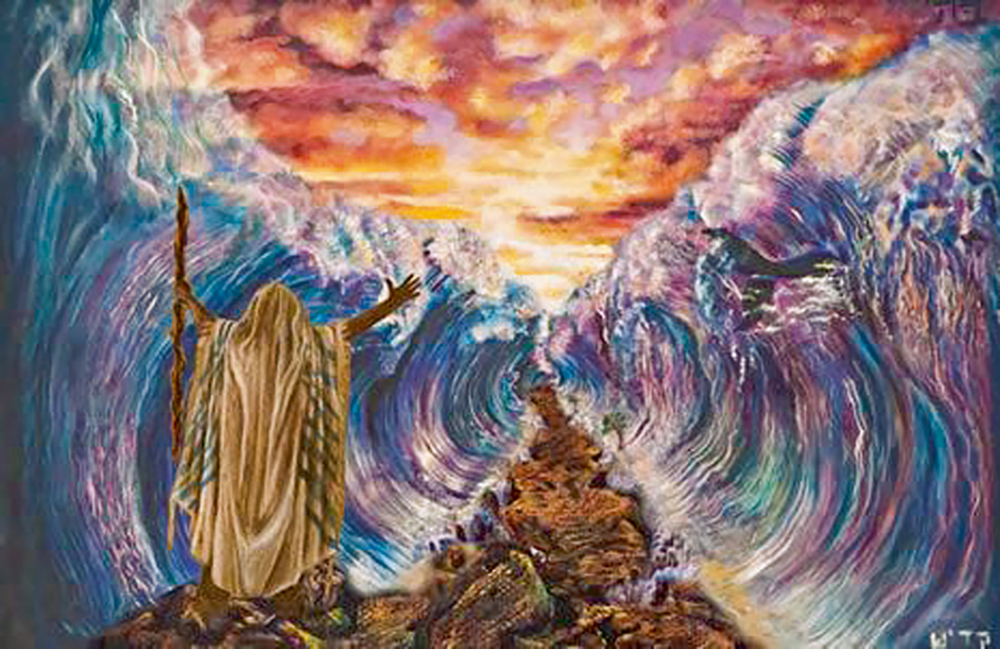By: Menachem Posner
What Was the Parting of the Red Sea?
The miracle of the parting of the Red Sea (keriat yam suf in Hebrew) was performed by G d through Moses, seven days after the Israelites’ Exodus from Egypt. Pharaoh and the Egyptian armies had pursued Israel to the water. Moses turned to G d in prayer, and G d instructed him to raise his staff. A strong east wind blew, and the sea parted, allowing the Israelites to walk through it on dry land. When the Egyptian pursuers attempted to follow, the water came crashing down, drowning them in its churning depths. Recognizing the great miracle that had occurred, Moses and the people of Israel sang the Song of the Sea, and Miriam led the women in song and dance.
The Lead-up to the Miracle
As told in the opening chapters of the Book of Exodus, the people of Israel had been enslaved by Pharaoh. G d saw their suffering and dispatched Moses and Aaron to set them free. After Moses brought the 10 plagues upon Pharaoh and his people, Pharaoh finally agreed to let the Israelites go free.
Following G d’s command, the Israelites took a circuitous route, giving the Egyptian spies among them the impression that they were lost in the desert. Pharaoh regretted having let his slaves escape and led his armies out to drag them back to Egypt and servitude.
The Midrash tells us that, seeing the approaching Egyptian army, the Jewish people were divided into four camps. There were those who said, “Let us throw ourselves into the sea.” A second group said, “Let us return to Egypt.” A third faction argued, “Let us wage war upon the Egyptians.” Finally, a fourth camp advocated, “Let us pray to G d.”
Moses, however, rejected all four options, saying to the people, “Fear not; stand by and see the salvation of G d which He will show you today. For as you have seen Egypt this day, you shall not see them again, forever. G d shall fight for you, and you shall be silent.”
G d then told Moses:
Why do you cry out to Me? Speak to the children of Israel and let them travel. And you raise your staff and stretch out your hand over the sea and split it, and the children of Israel shall come in the midst of the sea on dry land … And the Egyptians shall know that I am the L rd, when I will be glorified through Pharaoh, through his chariots, and through his horsemen.
At this point, a pillar of cloud (and the angel Michael), which generally led the people through the desert, wrapped itself around them from behind, protecting them from Egyptian arrows and projectiles. At the same time, the pillar of fire illuminated the night for the people of Israel.
The Parting of the Sea
Moses stretched out his hand over the sea, and G d battered the sea with the strong east wind all night, and He made the sea into dry land. According to the Midrash, at the same moment that the Red Sea parted, all the other water in the world split as well.
Then the Israelites walked right into the sea on dry land, and the solidified water towered over them on either side.
Seeing their prey in the middle of the sea, the Egyptians and their horses rushed in behind them, still in hot pursuit. As morning approached, G d turned His attention toward the Egyptians, using the cloud and fire to confuse them and emanate a painful heat. As the wheels came off their chariots, and the horses struggled in the boiling muck, the Egyptians were cast into complete turmoil.
Then, following G d’s command, Moses stretched his hand out over the sea, and it returned to its normal state. In the confusion that followed, Egyptians fled toward the sea, and G d stirred them into its churning depths.
Then, according to the Midrash, the sea spit the Egyptians’ remains onto the seashore so that the Israelites wouldn’t think that the Egyptians survived by walking through the sea in another miraculously dry passage. And the people “believed in G d and Moses His servant.”
The Song of Gratitude: Az Yashir
The Song at the Sea is so central to Jewish life that it is said every single day as part of the morning service. It is also known as Shirat Hayam or Az Yashir (“Then He Will Sing”), the opening words of the song as recorded in the Bible.
The way the Song of the Sea is laid out in a Torah scroll is unique. The text of the song is divided into small snippets, laid out to form a sort of brickwork, on an extra-wide column.
The song is 19 verses long. Here is a three-verse sample taken from the middle of the song:
Who is like You among the powerful, O L rd?
Who is like You, powerful in the holy place?
Too awesome for praises, performing wonders!
You inclined Your right hand; the earth swallowed them up.
With Your loving kindness You led the people You redeemed;
You led [them] with Your might to Your holy abode.
The song was sung by Moses and the people of Israel. According to one tradition, the people repeated after Moses, word by word. According to another tradition, Moses sang the song, and the people called out, “I will sing to G d,” after every refrain. A third tradition says that the people and Moses sang every word together in perfect unison.
We then read how Miriam, the prophetess, elder sister of Aaron and Moses, led the women in song and dance with tambourines in hand.
Where did they get their instruments? Very simple, says Rashi.4 Even during the times of darkest suffering, the Jewish women had complete faith that G d would save them, both from the land of Egypt and from the Egyptian pursuers. So ready for salvation were they, that they actually fashioned their instruments in Egypt and brought them along when they fled. Talk about saying “thanks in advance!”
Nachshon: The Trailblazer
How did the splitting of the sea happen? According to the Midrash, it all came down to one man named Nachson, the prince of the tribe of Judah. The sages share the following account:
When Israel stood facing the Red Sea, and the command was given to move forward, each of the tribes hesitated, saying, “We do not want to be the first to jump into the sea.”
Nachshon saw what was happening—and jumped into the sea.
At that moment Moses was standing and praying. G d said to him, “My beloved ones are drowning in the stormy seas, and you are standing and praying?”
Moses replied, “Master of the world, what am I to do?”
Said G d, “Lift your staff and spread your hand over the seas, which will split, and Israel will come into the sea upon dry land.”
And so it was. Following Nachshon’s lead, the Israelites entered the sea and were saved.
Experiencing G-d
Walking through the sea on dry land was quite an experience. G d spared no effort to make sure his people were comfortable. The biblical verses tell us that the seabed was dry, and the sages add that the sea walls grew fruit and spouted fresh water for the travelers. But it was more than just a watery spa. It was a spiritual delight. Tradition tells us, “What a maidservant saw on the sea, the prophet Ezekiel did not see [in his Divine visions].”5 Even the babies lifted their heads to behold the Divine presence.
The chassidic masters take it a step further.
Since water conceals everything beneath its waves, the sea represents the realm of that which is hidden, a spirituality so distant from ours that it is hidden from us. Splitting the sea and revealing the dry land on which the Jews could walk expresses the idea that the hidden realms become in some way revealed and accessible. Experiencing this event had a tremendous effect on each person, and prepared them for the greatest experience of all time: the giving of the Torah at Mount Sinai, which took place six weeks later.





